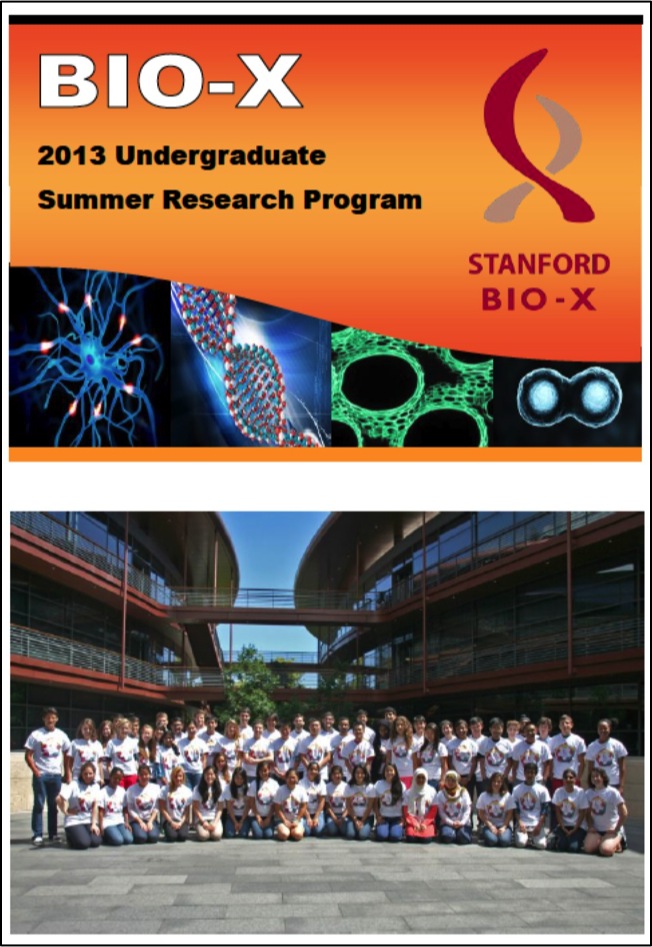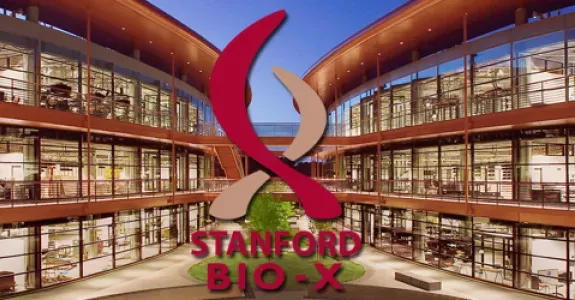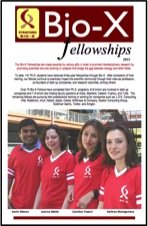
Welcome to the biweekly electronic newsletter from Stanford Bio-X for members of the Bio-X Corporate Forum. Please contact us if you would like to be added or removed from this distribution list, or if you have any questions about Stanford Bio-X or Stanford University.
Highlights
** On October 9, 2013, Bio-X celebrated the 10th Anniversary of the James H. Clark Center, the hub of Bio-X. Check out CLARK CENTER @ 10X on the SPLASH PAGE as well as the Bio-X Timeline over the last 15 years!!
** Check out the article by Stanford President John Hennessy in the Nov/Dec 2013 issue of the Stanford Magazine on Bio-X and the Clark Center, "A Cauldron of Innovation".
Seed Grants
** UPDATE: Bio-X has just recently closed its 7th RFP for the IIP Seed Grants, and has received 141 Letters of Intent!
 SEED GRANTS FOR SUCCESS - Stanford Bio-X Interdisciplinary Initiatives Program (IIP)
SEED GRANTS FOR SUCCESS - Stanford Bio-X Interdisciplinary Initiatives Program (IIP)
The Bio-X Interdisciplinary Initiatives Program represents a key Stanford Initiative to address challenges in human health. The IIP awards approximately $3 million every other year in the form of two-year grants averaging about $150,000 each. From its inception in 2000 through the fifth round in 2010, the program has provided critical early-stage funding to 114 different interdisciplinary projects, involving collaborations from over 300 faculty members, and creating over 450 teams from five different Stanford schools. From just the first 5 rounds, the IIP awards have resulted in a 10-fold-plus return on investment, as well as hundreds of publications, dozens of patents filed, and most importantly, the acceleration of scientific discovery and innovation.
In 2012, Stanford Bio-X selected 23 new seed grant projects as the winners of the 6th round. Please go here to view the list of awardees, along with the titles of their projects and the abstracts of the research. Competition was intense as the awardees were chosen from 118 Letters of Intent (LOIs). Selection criteria included innovation, high-reward, and interdisciplinary collaboration. (To view the 114 other IIP projects that have been funded from the first 5 rounds, please click here.) In addition, SANOFI has also funded 4 new Bio-X IIP Seed Grant projects from round 6!
We are cultivating and are highly successful in building meaningful collaborations with numerous corporate colleagues. New collaborations through our seed grant projects are highly encouraged. To learn about how to get involved, please contact Dr. Hanwei Li or Dr. Heideh Fattaey.
IIP Seed Grants-Related Events
** On Monday, March 3, 2014, Bio-X had a Poster Session, featuring 105 different posters from research by all scientists within the Stanford Bio-X community. Over 250 people attended the session, which allowed for an excellent venue to discuss science and research with colleagues from both academia and industry.
** On Monday, August 26, 2013, Bio-X had its second annual IIP Symposium of the year at the Clark Center, which highlights projects that exemplify the Stanford Bio-X mission of crossing boundaries to bring about interdisciplinary research and solutions in the field of life bioscience. The symposium was a huge success with over 300 people attending this event, which included 8 oral presentations and 136 poster presentations. Recorded talks from the symposium will be uploaded soon. If you'd like to view the talks for previous symposia through the years, please click here.
Fellowships
Every year, graduate students and postdoctoral scholars of Bio-X affiliated faculty are highly encouraged to apply for the Bio-X Fellowships, which are awarded to research projects that are interdisciplinary and utilize the technologies of different fields to solve different biological questions. Students are encouraged to work collaboratively with professors of different departments, thus creating cross-disciplinary relationships among the different Stanford schools. Our fellows have conducted exciting research, resulting in publications in high-impact journals and have been offered excellent positions in industry and academia. To date, Stanford Bio-X has a total of 152 Fellows.
On June 26, 2013, Bio-X held its annual Bio-X Fellows Symposium, where there were four 15-minute oral presentations followed by one-minute spiels from current fellows. The 25 newest fellows selected this year were also announced, and about 100 attendees came to the symposium. Please click on the "Bio-X Fellows Symposium" link above for the agenda and titles of the talks, and on the icon of the brochure above for the updated and latest Bio-X Fellowships brochure.
To view the numerous projects that have been awarded over the years, please click here.
 BIO-X UNDERGRADUATE SUMMER RESEARCH PROGRAM
BIO-X UNDERGRADUATE SUMMER RESEARCH PROGRAM
The Bio-X Undergraduate Summer Research Program supports undergraduate research training through an award designed to support interdisciplinary undergraduate summer research projects. The program is an invaluable opportunity for students to conduct hands-on research, learn how to carry out experiments in the laboratory, and develop the skills to read and analyze scientific literature.
This program is eligible to Stanford students who want to work in the labs of Bio-X affiliated faculty. To date, 241 students have been awarded the opportunity to participate in the Bio-X Undergraduate Summer Research Program. This summer is Stanford Bio-X's 8th round of USRP.
Participating undergraduates are also required to present poster presentations on the research that they've conducted during the program. Please click here for title lists of past posters that our undergraduates have presented.
Many fruitful collaborations and relationships have been established with industry through fellowships. Please contact Dr. Hanwei Li or Dr. Heideh Fattaey if you'd like to learn more about how to get involved with these fellowship programs.
News
 Neural activity promotes brain plasticity through myelin growth, researchers find
Neural activity promotes brain plasticity through myelin growth, researchers find
Bio-X Affiliated Faculty Michelle Monje
The brain is a wonderfully flexible and adaptive learning tool. For decades, researchers have known that this flexibility, called plasticity, comes from selective strengthening of well-used synapses — the connections between nerve cells. Now, researchers at the Stanford University School of Medicine have demonstrated that brain plasticity also comes from another mechanism: activity-dependent changes in the cells that insulate neural fibers and make them more efficient. These cells form a specialized type of insulation called myelin. “Myelin plasticity is a fascinating concept that may help to explain how the brain adapts in response to experience or training,” said Michelle Monje, MD, PhD, assistant professor of neurology and neurological sciences. The researchers’ findings are described in a paper published online April 10 in Science Express. “The findings illustrate a form of neural plasticity based in myelin, and future work on the molecular mechanisms responsible may ultimately shed light on a broad range of neurological and psychiatric diseases,” said Monje, senior author of the paper. The lead authors of the study are Stanford postdoctoral scholar Erin Gibson, PhD, and graduate student David Purger.

 Blood test could provide rapid, accurate method of detecting solid cancers, study finds
Blood test could provide rapid, accurate method of detecting solid cancers, study finds
Radiation Oncology Faculty Maximilian Diehn and Bio-X Affiliated Faculty Ash Alizadeh
A blood sample could one day be enough to diagnose many types of solid cancers, or to monitor the amount of cancer in a patient’s body and responses to treatment. Previous versions of the approach, which relies on monitoring levels of tumor DNA circulating in the blood, have required cumbersome and time-consuming steps to customize it to each patient or have not been sufficiently sensitive. Now, researchers at the Stanford University School of Medicine have devised a way to quickly bring the technique to the clinic. Their approach, which should be broadly applicable to many types of cancers, is highly sensitive and specific. With it they were able to accurately identify about 50 percent of people in the study with stage-1 lung cancer and all patients whose cancers were more advanced. “We set out to develop a method that overcomes two major hurdles in the circulating tumor DNA field,” said Maximilian Diehn, MD, PhD, the CRK Faculty Scholar and assistant professor of radiation oncology. “First, the technique needs to be very sensitive to detect the very small amounts of tumor DNA present in the blood. Second, to be clinically useful it’s necessary to have a test that works off the shelf for the majority of patients with a given cancer.” The researchers describe their findings in a paper published online April 6 in Nature Medicine. Diehn shares senior authorship with Ash Alizadeh, MD, PhD, assistant professor of medicine. Postdoctoral scholars Aaron Newman, PhD, and Scott Bratman, MD, PhD share lead authorship.
 Inspired by a music box, Stanford bioengineer creates $5 chemistry set
Inspired by a music box, Stanford bioengineer creates $5 chemistry set
Bio-X Affiliated Faculty Manu Prakash
When Manu Prakash was young he had a thing about flames. He's not encouraging all kids to follow his fiery lead – he did burn one hand pretty badly – but he thinks kids should explore more when it comes to learning about science. That's the idea behind his programmable, toy-like device that won a competition to "reimagine the chemistry set for the 21st century." The Science Play and Research Kit Competition (SPARK) was jointly sponsored by the Gordon and Betty Moore Foundation and the Society for Science & the Public. Prakash, an assistant professor of bioengineering at Stanford, will receive a $50,000 award toward further developing his prototype into a low-cost product, which he thinks can have widespread use both in the developing world and as a creative toy for kids. "In one part of our lab we've been focusing on frugal science and democratizing scientific tools to get them out to people around the world who will use them," Prakash said. "I'd started thinking about this connection between science education and global health. The things that you make for kids to explore science are also exactly the kind of things that you need in the field because they need to be robust and they need to be highly versatile."
 Stanford scientists discover a novel way to make ethanol without corn or other plants
Stanford scientists discover a novel way to make ethanol without corn or other plants
Bio-X Affiliated Faculty Matthew Kanan
Stanford University scientists have found a new, highly efficient way to produce liquid ethanol from carbon monoxide gas. This promising discovery could provide an eco-friendly alternative to conventional ethanol production from corn and other crops, say the scientists. Their results are published in the April 9 advanced online edition of the journal Nature. "We have discovered the first metal catalyst that can produce appreciable amounts of ethanol from carbon monoxide at room temperature and pressure – a notoriously difficult electrochemical reaction," said Matthew Kanan, an assistant professor of chemistry at Stanford and coauthor of the Nature study.
Events
| Pathology April 15, 2014, 12 pm - 1 pm Munzer Auditorium, Stanford, CA Tumor Biology Seminars- "Tuesday Cancer Talks" - New roles for sirtuins in tumor Metabolism Speaker: Marcia Haigis, PhD, Harvard Medical School |
Developmental Biology April 16, 2014, 4 pm - 5 pm Clark Center Auditorium, Stanford, CA Frontiers in Biology: "Wiring and unwiring the brain: role of microglia and the complement cascade" Speaker: Beth Stevens, Harvard |
| Biology April 21, 2014, 4 pm - 6 pm 393 Serra Mall, Herrin T-175, Stanford, CA "Damage Control - How the Pink1/Parkin pathway can regulate removal of impaired mitochondria by autophagy" Speaker: Richard Youle, National Institutes of Health |
Genetics April 23, 2014, 4 pm - 5 pm Clark Auditorium, Stanford, CA Frontiers in Biology Seminar: "Imaging RNA and RNA biology using RNA mimics of green fluorescent protein" Speaker: Samie R. Jaffrey MD, PhD |
Resources
| Stanford University |
| Stanford Bio-X |
| Bio-X Seed Grants The Stanford Bio-X Interdisciplinary Initiatives Program (IIP) provides seed funding for high-risk, high-reward, collaborative projects across the university, and have been highly successful in fostering transformative research. |
| Office of Technology and Licensing "Techfinder" Search the OTL Technology Portal to find technologies available for licensing from Stanford. |
| Stanford Center for Professional Development - Take advantage of your FREE membership! - Take online graduate courses in engineering, leadership and management, bioscience, and more. - Register for free webinars and seminars, and gets discounts on courses. |
| Stanford Biodesign Video Tutorials on how FDA approves medical devices A series of video briefs recently produced by the Stanford Biodesign Program teaches innovators how to get a medical device approved for use in the United States. This free, online library of 60 videos provides detailed information on the Food and Drug Administration regulatory process, short case studies and advice on interacting with the FDA. |
To learn more about Stanford Bio-X or Stanford University, please contact Dr. Hanwei Li, the Bio-X Corporate Forum Liaison, at 650-725-1523 or lhanwei1@stanford.edu, or Dr. Heideh Fattaey, the Executive Director of Bio-X Operations and Programs, at 650-799-1608 or hfattaey@stanford.edu.


